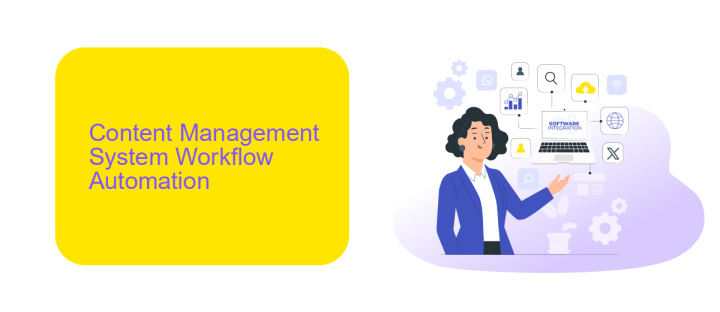Content Management System Workflow Automation
In today's fast-paced digital landscape, efficiency is paramount. Content Management System (CMS) workflow automation emerges as a game-changer, streamlining content creation, management, and distribution processes. By automating repetitive tasks and integrating seamlessly with various tools, CMS workflow automation enhances productivity, reduces errors, and ensures consistent content delivery. This article explores the benefits and implementation strategies of automating CMS workflows to optimize your digital operations.
Introduction
In today's fast-paced digital landscape, businesses are increasingly relying on Content Management Systems (CMS) to streamline their operations and maintain a competitive edge. CMS workflow automation plays a crucial role in optimizing these systems, enabling organizations to manage content more efficiently and effectively.
- Automated content publishing
- Seamless integration with third-party tools
- Enhanced collaboration among team members
- Improved content accuracy and consistency
- Time and cost savings
One of the key aspects of CMS workflow automation is the ability to integrate various services and tools seamlessly. For instance, ApiX-Drive offers a robust solution for setting up integrations without the need for extensive technical knowledge. By leveraging such services, businesses can ensure that their CMS workflows are not only automated but also highly efficient, leading to better content management and overall productivity.
Content Management System Workflow Automation

In today's fast-paced digital landscape, automating workflows within a Content Management System (CMS) is crucial for enhancing efficiency and productivity. By automating routine tasks such as content scheduling, publishing, and updates, organizations can significantly reduce manual effort and minimize the risk of errors. This not only ensures that content is delivered consistently and on time but also allows team members to focus on more strategic activities, thereby driving overall business growth.
One of the key aspects of CMS workflow automation is the integration of various tools and services to streamline processes. Services like ApiX-Drive can play a pivotal role in this regard. ApiX-Drive enables seamless integration between different applications, allowing data to flow effortlessly across platforms. This facilitates automated actions such as synchronizing content updates, managing user permissions, and generating reports. By leveraging such integrations, businesses can create a cohesive and efficient content management ecosystem that adapts to their evolving needs.
Benefits of Content Management System Workflow Automation

Implementing workflow automation in a Content Management System (CMS) offers numerous advantages that streamline operations and enhance productivity. By automating repetitive tasks, teams can focus on more strategic activities, reducing the likelihood of human error and ensuring consistency across content outputs.
- Increased Efficiency: Automation reduces the time spent on manual tasks, allowing for faster content creation and publication.
- Consistency and Accuracy: Automated workflows ensure that predefined processes are followed, minimizing discrepancies and errors.
- Improved Collaboration: With automated notifications and task assignments, team members can collaborate more effectively and stay aligned on project progress.
- Enhanced Scalability: Automation makes it easier to manage a growing volume of content without requiring a proportional increase in resources.
- Integration Capabilities: Services like ApiX-Drive enable seamless integration with various tools and platforms, further enhancing the CMS’s functionality.
By leveraging these benefits, organizations can optimize their content management processes, leading to higher quality outputs and a more agile response to market demands. Automation tools and services like ApiX-Drive provide the necessary infrastructure to integrate and streamline diverse workflows, ensuring a cohesive and efficient content management strategy.
Challenges of Content Management System Workflow Automation

Automating workflows within a Content Management System (CMS) can significantly enhance efficiency, but it also presents several challenges. One of the primary difficulties is the complexity of integrating various third-party tools and services. Ensuring seamless communication between these components often requires substantial technical expertise.
Another challenge is maintaining data consistency and accuracy. Automated workflows must be meticulously configured to prevent data discrepancies, which can lead to significant issues if not properly managed. Additionally, the initial setup and customization of automated workflows can be time-consuming and may require ongoing adjustments to accommodate evolving business needs.
- Integration complexities with third-party tools
- Ensuring data consistency and accuracy
- Time-consuming setup and customization
- Ongoing maintenance and updates
Services like ApiX-Drive can help mitigate some of these challenges by providing a user-friendly platform for integrating various applications and automating workflows without extensive coding knowledge. By leveraging such tools, businesses can streamline their CMS processes, reduce manual errors, and enhance overall productivity.
- Automate the work of an online store or landing
- Empower through integration
- Don't spend money on programmers and integrators
- Save time by automating routine tasks
Best Practices for Content Management System Workflow Automation
Effective workflow automation in a Content Management System (CMS) requires a strategic approach. Start by mapping out your content processes to identify repetitive tasks that can be automated. Utilize built-in CMS tools or third-party services like ApiX-Drive to streamline integrations between your CMS and other platforms. This will not only save time but also reduce the risk of human error, ensuring more consistent and reliable content management.
Regularly review and update your automated workflows to adapt to any changes in your content strategy or team structure. Ensure that your team is well-trained on how to use these automated systems effectively. Additionally, maintain clear documentation of your workflows and any custom integrations, so that any team member can understand and manage the system. By following these best practices, you can optimize your CMS workflow automation for maximum efficiency and productivity.
FAQ
What is CMS workflow automation?
How can I automate tasks within my CMS?
What are the benefits of automating CMS workflows?
Can I integrate my CMS with other tools for workflow automation?
Is it difficult to set up CMS workflow automation?
Do you want to achieve your goals in business, career and life faster and better? Do it with ApiX-Drive – a tool that will remove a significant part of the routine from workflows and free up additional time to achieve your goals. Test the capabilities of Apix-Drive for free – see for yourself the effectiveness of the tool.


